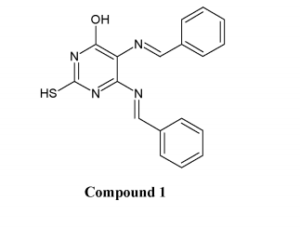Indian Institute of Science was founded in 1909. The company’s line of business includes Schools offering miscellaneous educational courses and services.
In India, the Pharmaceutical business of Indian Institute of Science is focused on Programmable tunnel thermionic mode transistor, Polypeptides for generating anti-influenza antibodies and uses thereof, Non-planar electrostatic discharge (ESD) protection devices with nano heat sinks.
Indian Institute of Science & KLE University’s College of Pharmacy filed patent application numbered 2713/CHE/2012 that is titled COMPOUNDS AS an INHIBITOR OF DNA DOUBLE-STRAND BREAK REPAIR METHODS AND APPLICATIONS THEREOF. This Patent Application has been granted as as Patent number 316878.
The invention covers Mechanical Engineering compound. This disclosure relates to compound of structural ‘formula 1’ and a method for preparing a compound of structural formula 1. The disclosure further relates to a method of arresting DNA double- strand break (DSB) repair by employing the compound of structural formula 1.

During patent examination, the patent examiner raised objections under Section 3(d) of the Indian Patents Act that the alleged compounds are considered as mere new forms/derivatives of known compounds. Hence, the said claims are not patentable in the absence of data on significantly improved therapeutic efficacy.
As a response to the said objection, the applicant explains the interpretation of 3(d) and brings case law to explain that while Section 3(d) tries to set a higher bar for inventions which try to extend the monopoly/patent term of an earlier/parent invention, it is important to distinguish the inventive ingenuity from small inconsequential changes. Mere substitutions in a styrene ring itself lead to significant changes in the physical, chemical and biological properties. Having said this, the introduction of a completely new/additional aryl moiety such as styrene is neither obvious, nor expected to possess similar physicochemical/biological properties vis-à-vis a compound with monoimine (single styrene moiety) functionality. To further establish this fact, the Applicants refer to the two documents (Hruschka et al enclosed as Annexure B and Sztanke et al enclosed as Annexure C) which has been extensively discussed in the inventive step section.
Advocate Rahul Dev is a Patent Attorney & International Business Lawyer practicing Technology, Intellectual Property & Corporate Laws. He is reachable at rd (at) patentbusinesslawyer (dot) com & @rdpatentlawyer on Twitter.
Quoted in and contributed to 50+ national & international publications (Bloomberg, FirstPost, SwissInfo, Outlook Money, Yahoo News, Times of India, Economic Times, Business Standard, Quartz, Global Legal Post, International Bar Association, LawAsia, BioSpectrum Asia, Digital News Asia, e27, Leaders Speak, Entrepreneur India, VCCircle, AutoTech).
Regularly invited to speak at international & national platforms (conferences, TV channels, seminars, corporate trainings, government workshops) on technology, patents, business strategy, legal developments, leadership & management.

